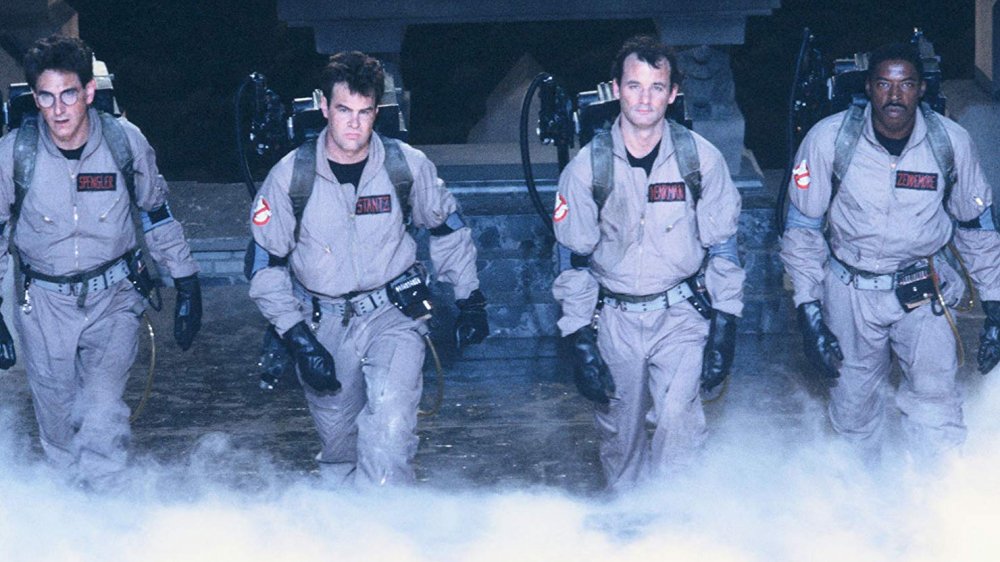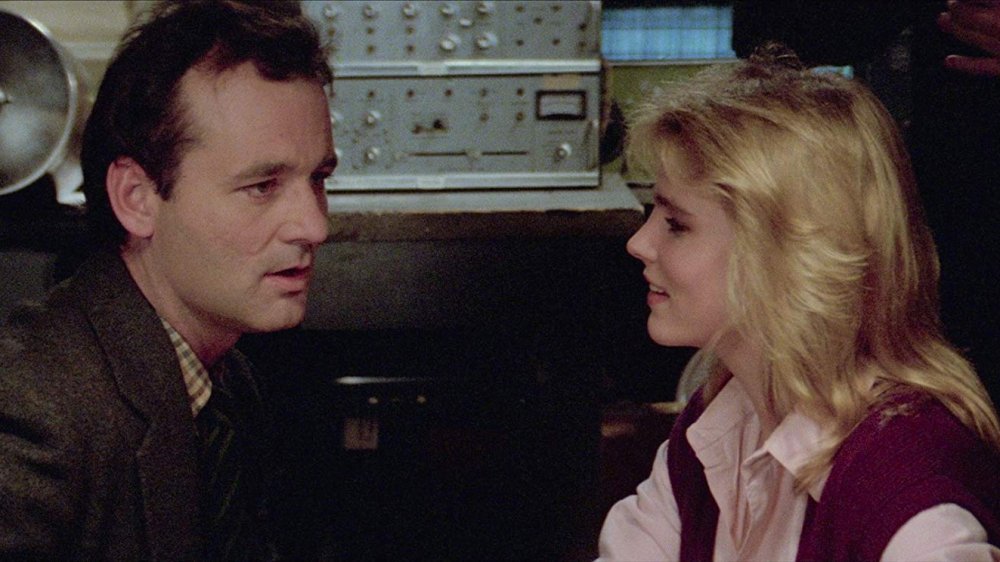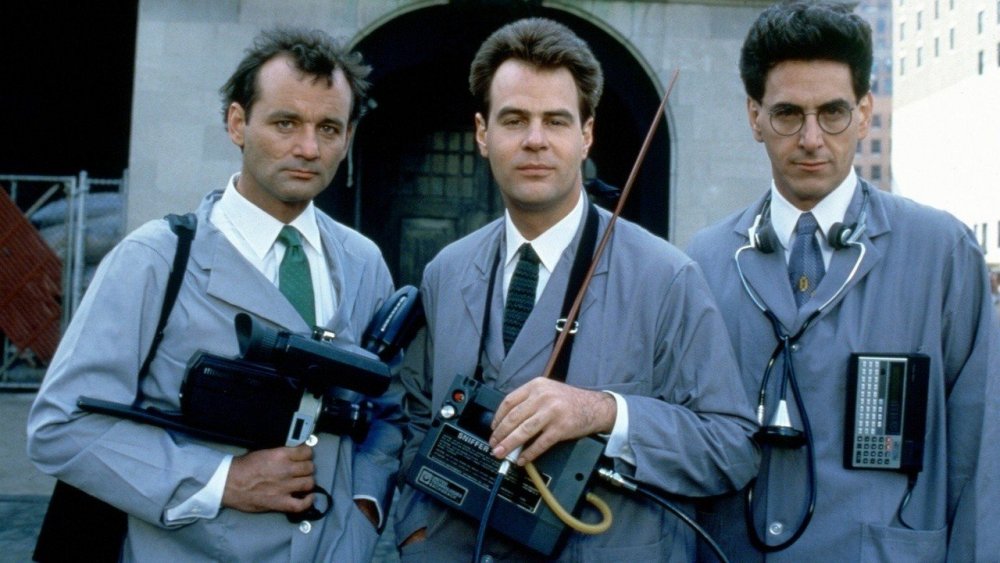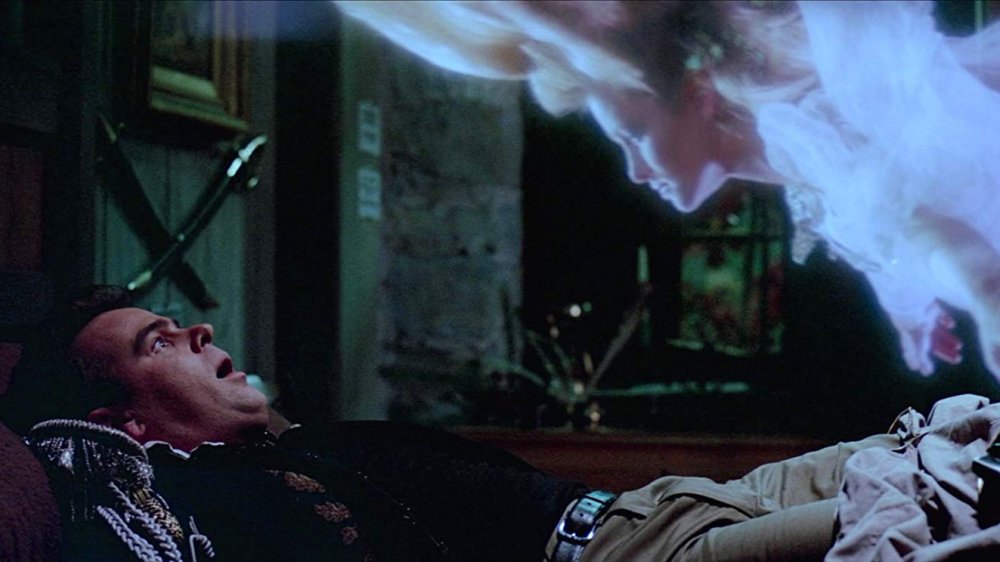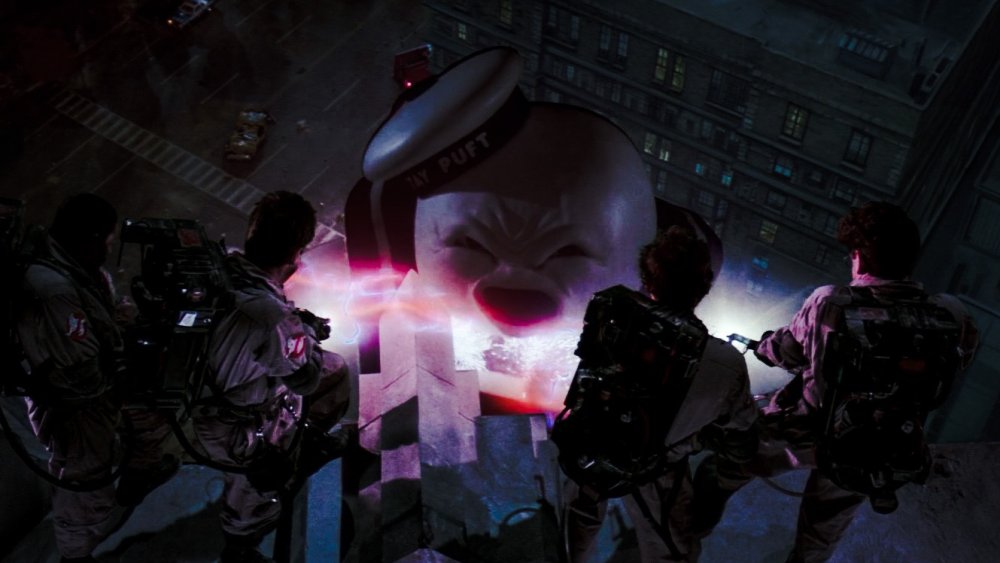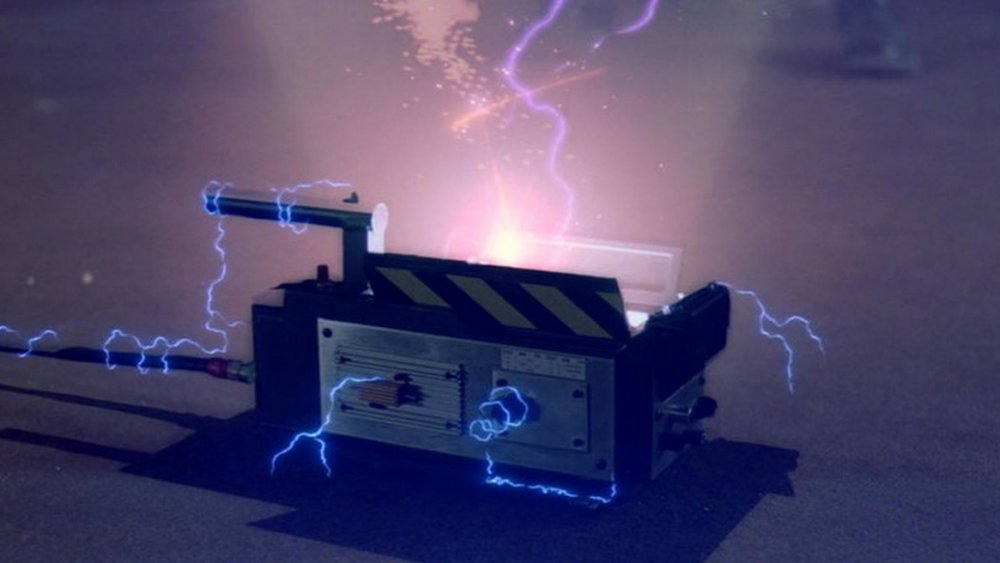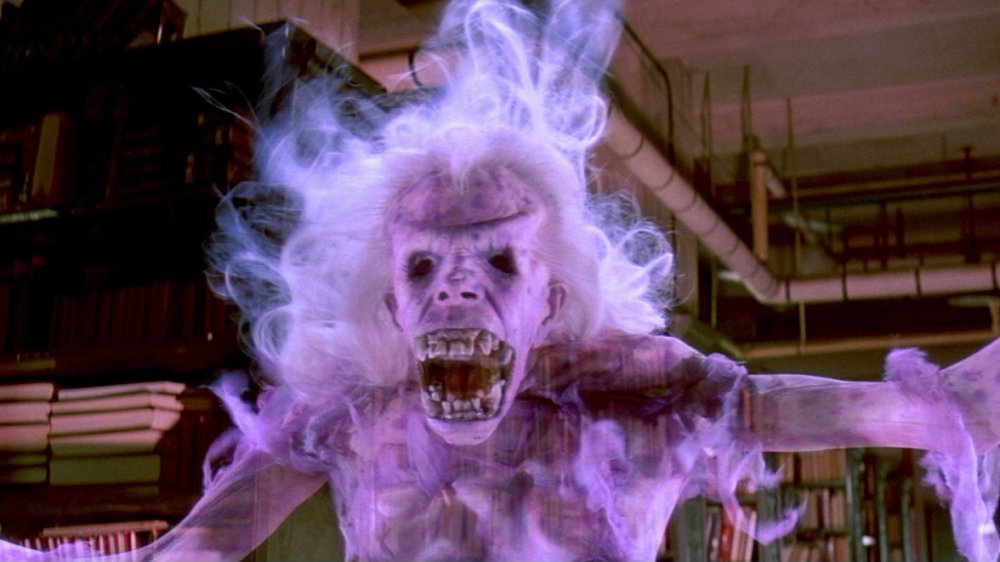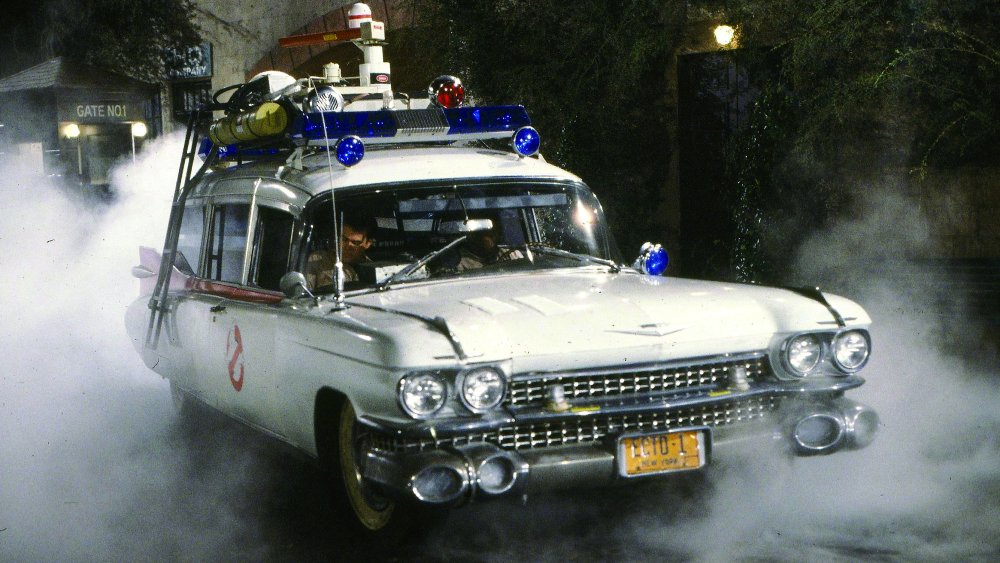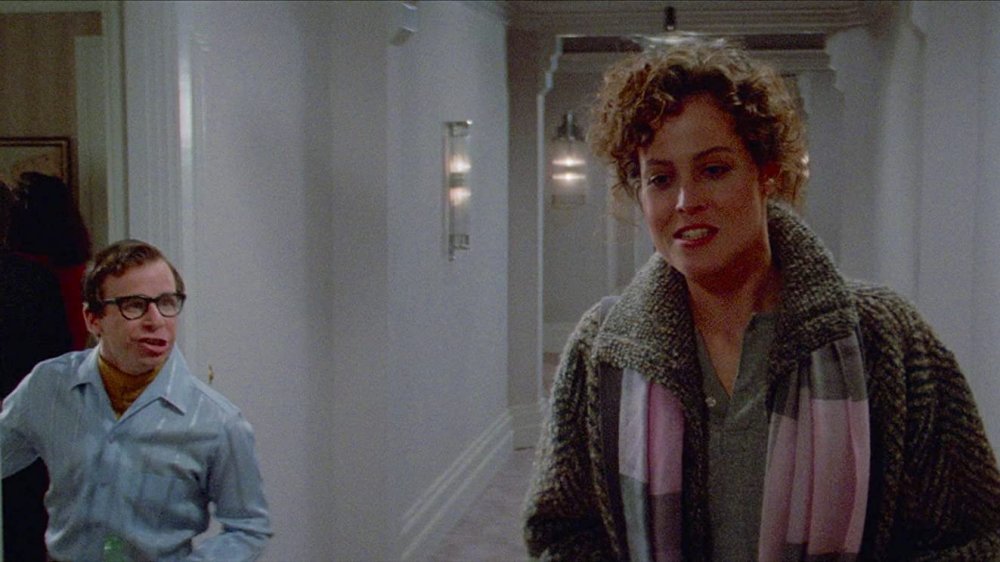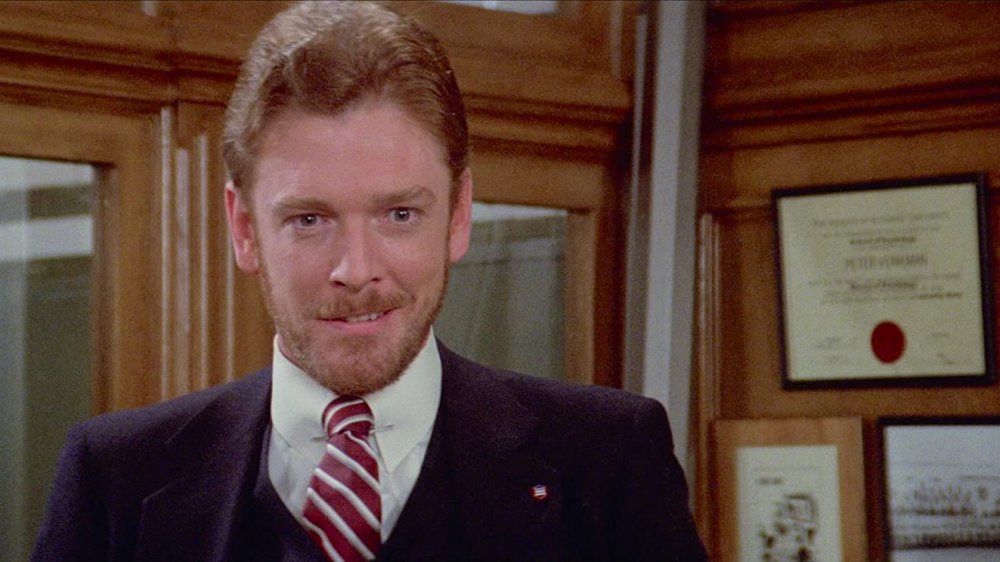Things Only Adults Notice In Ghostbusters
In 1984, one of the most beloved comedy films of all time was released and soon became a favorite for fans of all ages. Ghostbusters, the story of a group of scientists who figure out that ghosts are real and then start a business framed around catching spirits, became a childhood favorite for many pretty much as soon as they saw it. From the VHS days all the way through to the streaming era, we just keep revisiting this classic.
That means that Ghostbusters is also the kind of film that we keep finding new layers in as we continue to revisit it. Your first time seeing the film, perhaps at a sleepover or during Friday night family movie time, is not the same as your most recent screening. For kids, it's a fun film full of spooky-but-not-terrifying creatures and rapid-fire jokes. For the older folks in the audience, it's still all of that, but... let's just say some of the implications of the world set up by Ghostbusters are interesting. These are things only adults notice in Ghostbusters.
Creepy Venkman
When you watch Ghostbusters as a kid, there's a good chance you get the sense that Dr. Peter Venkman (Bill Murray) is the guy the movie would like you to aspire to be. After all, he still gets to be a successful business founder like his buddies Ray and Egon, but he also gets to crack jokes all the time, and he's the one who gets the girl by the end of the movie. Venkman is very clearly put in position to be the Cool Ghostbuster, but when you watch the film as an adult, particularly in the 21st century, it also becomes clear that he's kind of a creep.
When we first meet Peter Venkman, he's conducting an experiment on a pair of volunteer college students, one of whom is an attractive young woman. He delights in torturing the other, male subject of the experiment, while lavishing the woman with praise in an effort to possibly hook up with her later. He's also flat-out lying to her by telling her she has ESP, just so he can sleep with her later. When he meets Dana, it's clear that she sees through him a bit more, but he's still not the most sincere guy in the world with her. Of all the Ghostbusters, Venkman is the one most likely to lie his way into bed with a woman, and it's not always easy to overlook.
Scientific community
Much of the main plot of Ghostbusters involves the titular team essentially finding financial success as alternative exterminators. They have a station, they have equipment, they have a rapid response vehicle, and they go out in jumpsuits and trap ghosts, much like a pest control expert would set up traps to get rats out of your attic. Before that, though, the Ghostbusters were scientists who made a major breakthrough in their field: They confirmed not just that ghosts were real, but that they could be contained.
We see montages of the Ghostbusters' success as it echoes around the world and makes them into celebrities, but what the movie never shows us is the rest of the scientific community responding to their breakthrough in an active way. Are they sharing their tech with other scientists? Are other labs trying to develop their own ghost equipment? Since they're making so much money, you might think they'd franchise, but we never see that come to fruition either. For such massive overnight successes, you'd think they'd have a little more attention from other scientists.
Ghost love?
One of the most infamous scenes in Ghostbusters is a brief moment in the middle of the montage showing off the success of the Ghosbusters business. As the film makes it clear that our boys are working long hours, grabbing sleep where they can in a dormitory style shared bedroom, Ray Stantz (Dan Aykroyd) has a dream. In the dream, he's lying in an ornate bed with a beautiful ghostly presence hovering over him. Then his pants unzip and Ray's eyes cross, implying that the ghost is, uh, servicing his proton pack.
What's interesting about this dream, and the fact that the film bothered to show it to us, is that apart from this moment Ghostbusters never really attempts to highlight any good-natured or helpful ghosts. At best, most of the ghosts in the film are cast as pests, and at worst they're outright evil spirits. Yet here Ray is imagining his dream woman as a gorgeous ghostly being who wants to give him pleasure. With this mind, and his enthusiasm for his work, we're forced to ask: Is Ray's particular kink having ghost sex? If so, it might be better to be open about it now before it starts to really complicate his work.
The Stay Puft brand
Perhaps the most memorable visual in all of Ghostbusters comes near the end of the film, when Gozer demands that the team choose the form of the destroyer that's coming to ravage the city. They try to empty their minds, but Ray can't help a thought from popping into his head. And that's when a massive marshmallow mascot shows up to stomp through New York City.
The Stay Puft Marshmallow Man doesn't have time to do a whole lot of damage before the Ghostbusters manage to essentially roast him, but he does crash through a good portion of Manhattan and the resulting marshmallow goo covers quite a bit of Fifth Avenue by the time it's all over. The whole city, and by extension the whole country, saw what happened. So... what do the owners of Stay Puft do in response to this? Do they put out a statement clarifying that they had no involvement in their mascot's hijinks? Do they change mascots? Do they lean into and claim they make the biggest marshmallows in the world? When you're an adult who's very used to brands making various plays for attention, it becomes a question worth asking.
Ghost jail
Ghostbusters doesn't spend all that much time breaking down how the system of ghost capture and control actually works, but we do get a glimpse into what happens to the spirits after the boys bust them. As Ray explains to Winston, they put the trapped ghosts into their specially designed storage facility, which is basically some kind of electronic grid that stores the ghosts in a secure way.
We learn over the course of the film that the grid is getting very "crowded" due to Gozer's return and the rise of psychic energy in the city, and we also learn that the Environment Protection Agency is concerned about whatever hazards the grid might pose. What the film doesn't ever explore is what, if anything, the ghosts actually think or feel about their new home. The ghosts we see over the course of the film at least some of the time appear to be semi-sentient creatures, and many of them appear to be mischievous but not outright evil. Is it, for lack of a better word, humane to keep them all trapped in there? Can they feel it? Perhaps the ACLU needs to do some sniffing around that grid instead of the EPA.
Ghost morality
Over the course of the film, the Ghostbusters — and by extension, various New Yorkers — encounter all kinds of supernatural apparitions and entities. It begins with a ghost in a library that morphs from a quiet old woman to a terrifying specter, and then progresses to include everything from Slimer to the skeletal taxi driver to Gozer's hounds. Some of these ghosts seem like genuinely terrifying beings that no one would want to be around, while others seem a bit more quirky, and less prone to actually inflicting harm on anyone.
Still, to the Ghostbusters, they all seem to just be another form of pest, like roaches or silverfish. Their job isn't to reason with the ghosts, or to judge them, or to even separate the bad ones from the relatively good. They just seem to be trapping them and storing them in their special grid. From a kid's point of view, this probably makes sense, but watching the film as an adult you may get the overwhelming sense that this probably isn't fair to some of those ghosts, the ones that were just doing a little quiet haunting and basically minding their own business. Is there any kind of screening system that the Ghostbusters employ, or are they just locking all of those ghosts up together? Perhaps one day Egon Spengler went on to teach a class on the Ethics of Busting.
Ghostbusters and law enforcement
Ghostbusters is a fun, breezy movie that's basically about a group of guys who start a small business, prove there's a demand for what they're selling, and then watch as their business blows up in the midst of a crisis. There's not a lot of time to really get into the logistics of what the team does, or the broader impact it has on New York City, and the film doesn't really need to shed more light on it. It's not what the film is for, and when you're a kid you don't necessarily think about it.
When you watch the film as an adult, though, there's a good chance your brain will start to turn to the various economic, social, and logistical challenges presented by what is basically a brand new service. The Ghostbusters are in many ways set up like exterminators, but most exterminators don't have a car equipped with lights and sirens that allows them speed through the streets with impunity. How do the NYPD and the FDNY feel about these guys? Do they ever get a heads-up when they're out on a job? Do they ever work together? If not, it feels like maybe the Ghostbusters should have given them a little more warning.
Dana and Louis
The major supernatural antagonist in Ghostbusters is Gozer, a powerful entity that seeks to re-enter the earthly plane via Dana's apartment building, which basically acts as a tuning fork for psychic energy and will open a portal for Gozer. Before that can happen, though, Gozer has to possess two people to become its "Keymaster" and "Gatekeeper." Gozer finds these people in neighbors Dana Barrett and Louis Tully, and ultimately manages to possess them both with its servants Zuul and Vinz Clortho, respectively.
When the Gatekeeper and the Keymaster finally meet in Dana's ruined apartment, they share a passionate kiss and then walk up a supernatural staircase to the roof of the building. The next time we see them, the adults in the room might notice that it certainly appears from Louis' expression and posture that the two just had some rather hasty sex. It's not clear from the end of the film how much either person remembers, or might later remember, about their encounter. So, if they did have sex, are these awkward neighbors going to uncover some really weird memories later?
EPA failure
While Gozer is the main antagonist of the film, Ghostbusters also has another major bad guy in the form of Walter Peck, from the "third district" of the Environmental Protection Agency. The idea that a government agency wants to have a look at what these guys have cooking at their brand-new, possibly dangerous business isn't anything strange. After all, Venkman himself admits that they all have an "unlicensed nuclear accelerator" on their backs in the form of proton packs. But when Peck actually tries to do his job, it becomes clear that he's very, very bad at it. Like, on the most basic level.
First, Peck asks to see the Ghostbusters ghost storage facility. Venkman won't let him, so he goes and gets a court order, which for a guy in his job actually makes a lot of sense. Then he uses that court order to... turn the Ghostbusters' grid off without any scientific investigation? Think of the things he could learn, the regulations he could write, and instead he's just keen on shutting them down with barely a look. Then he goes to the mayor and calls it all a hoax despite the grid blowing up.
Many critics have viewed Peck as the film's response to government regulation as an impediment to small business owners, which would certainly explain Peck's cartoonish incompetence. That said, he could be at least a little more thorough.
